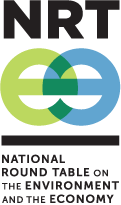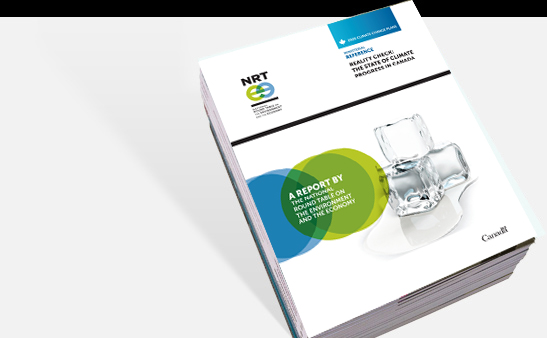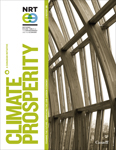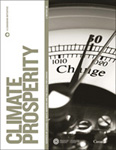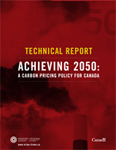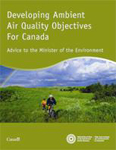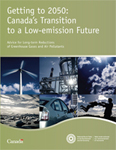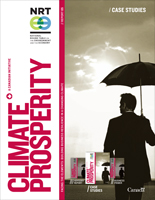EBA Engineering Consultant Limited, A Tetra Tech Company – Case Study
FACING THE ELEMENTS: Building Business Resilience in a Changing Climate
AT A GLANCE // |
Location:Edmonton, Alberta Industry:Consulting Engineering and Sciences Services Employees (2011):650 Total sales (2010):US$100 million |
Key adaptation
|
Adaptation
|
Business BenefitsEstablished reputation bringing repeat business and new contracts |
COMPANY OVERVIEW //
EDMONTON, ALBERTA
www.eba.ca
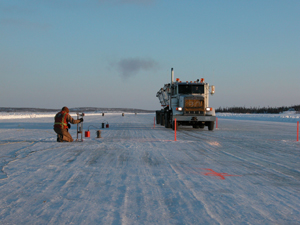
Measuring ice deflection on the Tibbitt
to Contwoyto winter road in the Northwest
Territories (photo credit: Don Hayley)
EBA offers planning, design, regulatory permitting and project management services for mining, energy, transportation and infrastructure development.
EBA is renowned for its engineering expertise in areas of permafrost, ice and winter conditions. EBA’s Arctic division is the largest dedicated team in Canada for engineering consultancy services in Arctic conditions, with a total of 80 employees in Edmonton (Alberta), Yellowknife (Northwest Territories) and Whitehorse (Yukon).
ENGINEERING-BASED ACTIVITIES IN THE CANADIAN NORTH IN A CHANGING CLIMATE
Climate is changing across Canada, and northern parts of the country have been most intensely affected.32 According to records from weather stations north of the 60th parallel, the rate of warming in northern latitudes has been greater than the global world average in recent decades, corresponding to an average increase of 0.09°C per decade. This is due in part to the reflective properties of ice and snow.33 Climate model projections predict a possible average temperature increase in the Arctic this century of approximately 6°C compared with 1980-1999, varying from 3.5°C to 12.5°C depending on the model and greenhouse gas emissions scenario considered.34
Warming in Canada’s North will affect sea ice, snow cover, ice sheets, lake levels, river flow, permafrost conditions and local topography.35 This will translate into opportunities and risks.
Economically, Canada’s North could benefit from several changes:
// Increased shipping through the Northwest passage;
// Reduced costs of oil, gas and mining exploration; and
// Increased forest cover.
However, there are considerable risks for existing infrastructure. For example, warming and reduced ice cover pose threats to winter roads. These roads are built out of snow and ice, connecting isolated mining camps and resource exploration lands during the few months in the winter when the muskeg and lakes are frozen over. They play a critical socio-economic function for communities and businesses in Canada’s North, as emphasised by the TV show “Ice Road Truckers”.i In recent years, safe operating days on ice roads are more difficult to predict because of the warming trend and more frequent warm temperature extremes.36
Finally, impacts on built infrastructure will be compounded by risks to the natural environment. A number of fauna and flora in northern Canada have narrow habitats and niche requirements, which make them sensitive to climate change.37 Although they are well-adapted to current extreme climate conditions, warming and reduced ice and snow cover have been shown to contribute to increased mortality rates, reduced reproductive capacity and higher competition for resources.38 This will have critical implications for Aboriginal ways of life in the Canadian North who rely on Arctic plants and animals for their diet, traditions and cultures.
DRIVERS
EBA routinely considers climate risk management as part of its core business services. This is explained by the company’s early involvement in northern projects.j
Ambient conditions in Canada’s North are extreme and fast changing. Further, meteorological and environmental observations are limited in the North. As a result, most engineering projects in the North require a strong research component aimed at understanding local conditions. This explains why EBA started analyzing environmental changes and developing adaptation solutions before most other engineering companies.
A FOCUS ON TECHNICAL SOLUTIONS
Over the past 20 to 30 years, EBA’s professionals developed innovative engineering methodologies and technical solutions to manage climate variability and long-term changes.
For example, EBA developed a technique to build frozen core dams out of permafrost for the EKATI diamond mine in 1995. Part of the engineering challenge consisted of ensuring that the permafrost foundation would remain frozen over the asset lifetime. To achieve robust design standards, EBA refined its ground thermal analysis to incorporate the most recent warming observations, knowledge of climate variability and long-term warming projections. Frozen core dams became a proven successful and cost-effective technique to build dams in Arctic conditions with cold continuous permafrost.
EBA has also done considerable work to improve the design and construction of winter roads. By optimizing engineering practices, EBA’s engineers made it possible to increase truck loads on ice roads, while coping with increased warming and reduced ice cover.
EBA contributed to the 2010 Canadian Standards Association technical guide “Infrastructure in permafrost: A guideline for climate change adaptation”, as well as the updated Alberta best practice guidelines for building and working safely on ice covers with consideration of future climate change.39
Due to its expertise, EBA also offers technical assistance on dedicated climate adaptation projects. For example, EBA prepared a guideline for the Transportation Association of Canada in 2010 on the development and management of transportation infrastructure in permafrost regions, which included a review of climate change impacts and adaptation for roads in Canada’s North.40
BENEFITS AND/OR CHALLENGES
EBA’s management approach of climate and environmental changes has earned the company a good reputation for designing robust engineering projects in Canada’s North in such a way as to receive planning approval, even from the most stringent regulators. This has ensured considerable repeat business, as well as contracts from new clients for EBA’s Arctic division.
EBA has developed its robust management approach by working with universities and government agencies, such as the University of Alberta and Natural Resources Canada, on how to apply fundamental research to “real life” engineering projects.
PERSPECTIVES ON GOVERNMENT ROLES
EBA believes that those actively working in the Canadian North and governments have a role in educating the public, especially potential investors, on the challenges of climate variability and longterm change for the built environment. This would influence businesses to consider routinely climate risk for new projects and existing assets, as well as raise awareness on the avoided cost of climate change if adaptation measures are adopted.
Government also has the responsibility to provide quality data and support research on a changing climate and its impacts, for use by project promoters, and engineering consultants. It is EBA’s opinion that this role is currently well managed by both federal and provincial and territorial governments.
Finally, government can favour climate change adaptation through regulation and/or guidance, especially at the permit review stage.
[i] Early episodes of the TV show were filmed on the Tibbitt to Contwoyto Winter Road, which services the diamond mining industry in the Lac de Gras region of Northwest Territories.
[j] The company’s engineers worked on the first Canadian surface and underground diamond mine, EKATI, in the Northwest Territories.
[31] Canadian Consulting Engineer 2010
[32] Far North Science Advisory Panel 2010; Furgal and Prowse 2008
[33] International Arctic Science Committee 2010
[34] Furgal and Prowse 2008
[35] Far North Science Advisory Panel 2010
[36] International Arctic Science Committee 2010
[37] Furgal and Prowse 2008
[38] Furgal and Prowse 2008
[39] Canadian Standards Association 2010; Government of Alberta 2009
[40] McGregor, Hassan, and Hayley 2008
